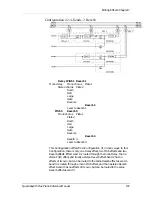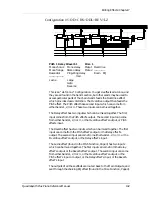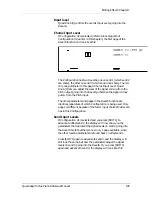
Editing Effects: Chapter 7
QuadraSynth Plus Piano Reference Manual
151
Reverb (Page 4)
Density
Density controls how the first reflection of the reverb effect will
appear. When set to 0, the first reflection is heard alone without
any other reflections. When set to 99, the first reflection appears
to “fade-in” and then “fade-out”. This is because a number of
reflections will occur just before and just after the first reflection,
in addition to the remaining reflections heard after the first
reflection. Thus, the reverb sounds more “dense”.
If the select Reverb type is Large, the Density parameter is
unavailable.
Diffusion
Diffusion determines the “thickness” of the reverb sound by
adding more reflections to the reverb’s decay. With lower
diffusion settings, you may be able to actually hear the
individual echoes that make up the overall reverb sound. With
higher diffusion settings, the echoes increase in number and
blend together, washing out the reverb’s decay. Greater
diffusion works better with percussive sounds, whereas less
amounts of diffusion work well with vocals and other sustained
sounds.
Note:
The illustration above reflects a Density setting of 0.
Summary of Contents for QuadraSynth Plus
Page 1: ...ALESIS QuadraSynth Plus Reference Manual ...
Page 3: ......
Page 10: ...Setting Up Chapter 1 QuadraSynth Plus Piano Reference Manual 11 ...
Page 56: ...Overview Chapter 4 QuadraSynth Plus Piano Reference Manual 57 ...
Page 63: ...Editing Mixes Chapter 5 QuadraSynth Plus Piano Reference Manual 64 ...
Page 77: ...Editing Programs Chapter 6 QuadraSynth Plus Piano Reference Manual 78 ...
Page 152: ...Editing Effects Chapter 7 QuadraSynth Plus Piano Reference Manual 153 ...
Page 163: ...Editing Effects Chapter 7 QuadraSynth Plus Piano Reference Manual 164 ...
Page 178: ...Troubleshooting Appendix A QuadraSynth Plus Piano Reference Manual 179 ...
Page 179: ......
Page 191: ...Parameters Index Appendix C QuadraSynth Plus Piano Reference Manual 192 ...






























